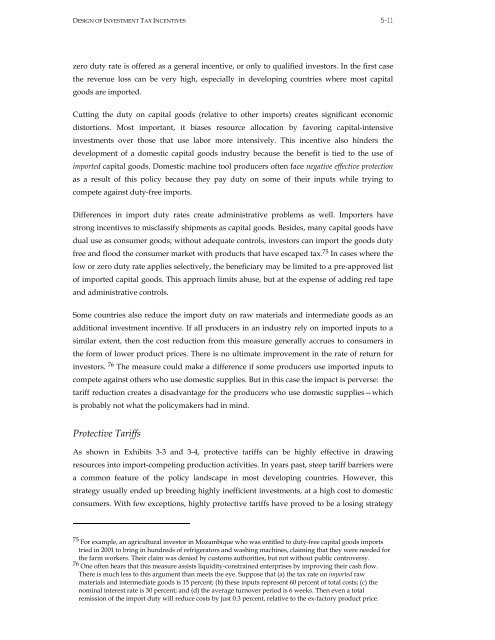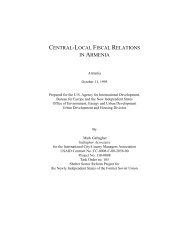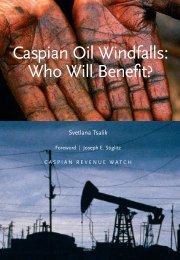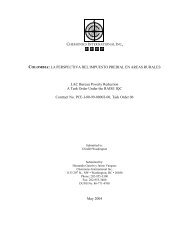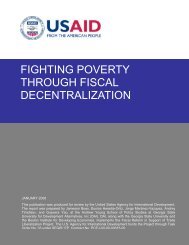Effectiveness and Economic Impact of Tax Incentives in the SADC ...
Effectiveness and Economic Impact of Tax Incentives in the SADC ...
Effectiveness and Economic Impact of Tax Incentives in the SADC ...
You also want an ePaper? Increase the reach of your titles
YUMPU automatically turns print PDFs into web optimized ePapers that Google loves.
DESIGN OF INVESTMENT TAX INCENTIVES 5-11<br />
zero duty rate is <strong>of</strong>fered as a general <strong>in</strong>centive, or only to qualified <strong>in</strong>vestors. In <strong>the</strong> first case<br />
<strong>the</strong> revenue loss can be very high, especially <strong>in</strong> develop<strong>in</strong>g countries where most capital<br />
goods are imported.<br />
Cutt<strong>in</strong>g <strong>the</strong> duty on capital goods (relative to o<strong>the</strong>r imports) creates significant economic<br />
distortions. Most important, it biases resource allocation by favor<strong>in</strong>g capital-<strong>in</strong>tensive<br />
<strong>in</strong>vestments over those that use labor more <strong>in</strong>tensively. This <strong>in</strong>centive also h<strong>in</strong>ders <strong>the</strong><br />
development <strong>of</strong> a domestic capital goods <strong>in</strong>dustry because <strong>the</strong> benefit is tied to <strong>the</strong> use <strong>of</strong><br />
imported capital goods. Domestic mach<strong>in</strong>e tool producers <strong>of</strong>ten face negative effective protection<br />
as a result <strong>of</strong> this policy because <strong>the</strong>y pay duty on some <strong>of</strong> <strong>the</strong>ir <strong>in</strong>puts while try<strong>in</strong>g to<br />
compete aga<strong>in</strong>st duty-free imports.<br />
Differences <strong>in</strong> import duty rates create adm<strong>in</strong>istrative problems as well. Importers have<br />
strong <strong>in</strong>centives to misclassify shipments as capital goods. Besides, many capital goods have<br />
dual use as consumer goods; without adequate controls, <strong>in</strong>vestors can import <strong>the</strong> goods duty<br />
free <strong>and</strong> flood <strong>the</strong> consumer market with products that have escaped tax. 75 In cases where <strong>the</strong><br />
low or zero duty rate applies selectively, <strong>the</strong> beneficiary may be limited to a pre-approved list<br />
<strong>of</strong> imported capital goods. This approach limits abuse, but at <strong>the</strong> expense <strong>of</strong> add<strong>in</strong>g red tape<br />
<strong>and</strong> adm<strong>in</strong>istrative controls.<br />
Some countries also reduce <strong>the</strong> import duty on raw materials <strong>and</strong> <strong>in</strong>termediate goods as an<br />
additional <strong>in</strong>vestment <strong>in</strong>centive. If all producers <strong>in</strong> an <strong>in</strong>dustry rely on imported <strong>in</strong>puts to a<br />
similar extent, <strong>the</strong>n <strong>the</strong> cost reduction from this measure generally accrues to consumers <strong>in</strong><br />
<strong>the</strong> form <strong>of</strong> lower product prices. There is no ultimate improvement <strong>in</strong> <strong>the</strong> rate <strong>of</strong> return for<br />
<strong>in</strong>vestors. 76 The measure could make a difference if some producers use imported <strong>in</strong>puts to<br />
compete aga<strong>in</strong>st o<strong>the</strong>rs who use domestic supplies. But <strong>in</strong> this case <strong>the</strong> impact is perverse: <strong>the</strong><br />
tariff reduction creates a disadvantage for <strong>the</strong> producers who use domestic supplies—which<br />
is probably not what <strong>the</strong> policymakers had <strong>in</strong> m<strong>in</strong>d.<br />
Protective Tariffs<br />
As shown <strong>in</strong> Exhibits 3-3 <strong>and</strong> 3-4, protective tariffs can be highly effective <strong>in</strong> draw<strong>in</strong>g<br />
resources <strong>in</strong>to import-compet<strong>in</strong>g production activities. In years past, steep tariff barriers were<br />
a common feature <strong>of</strong> <strong>the</strong> policy l<strong>and</strong>scape <strong>in</strong> most develop<strong>in</strong>g countries. However, this<br />
strategy usually ended up breed<strong>in</strong>g highly <strong>in</strong>efficient <strong>in</strong>vestments, at a high cost to domestic<br />
consumers. With few exceptions, highly protective tariffs have proved to be a los<strong>in</strong>g strategy<br />
75 For example, an agricultural <strong>in</strong>vestor <strong>in</strong> Mozambique who was entitled to duty-free capital goods imports<br />
tried <strong>in</strong> 2001 to br<strong>in</strong>g <strong>in</strong> hundreds <strong>of</strong> refrigerators <strong>and</strong> wash<strong>in</strong>g mach<strong>in</strong>es, claim<strong>in</strong>g that <strong>the</strong>y were needed for<br />
<strong>the</strong> farm workers. Their claim was denied by customs authorities, but not without public controversy.<br />
76 One <strong>of</strong>ten hears that this measure assists liquidity-constra<strong>in</strong>ed enterprises by improv<strong>in</strong>g <strong>the</strong>ir cash flow.<br />
There is much less to this argument than meets <strong>the</strong> eye. Suppose that (a) <strong>the</strong> tax rate on imported raw<br />
materials <strong>and</strong> <strong>in</strong>termediate goods is 15 percent; (b) <strong>the</strong>se <strong>in</strong>puts represent 60 percent <strong>of</strong> total costs; (c) <strong>the</strong><br />
nom<strong>in</strong>al <strong>in</strong>terest rate is 30 percent; <strong>and</strong> (d) <strong>the</strong> average turnover period is 6 weeks. Then even a total<br />
remission <strong>of</strong> <strong>the</strong> import duty will reduce costs by just 0.3 percent, relative to <strong>the</strong> ex-factory product price.


